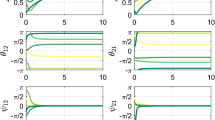Abstract
In this paper we address the question of how interactions affect the formation and organization of receptive fields in a network composed of interacting neurons with Hebbian-type learning. We show how to partially decouple single cell effects from network effects, and how some phenomenological models can be seen as approximations to these learning networks. We show that the interaction affects the structure of receptive fields. We also demonstrate how the organization of different receptive fields across the cortex is influenced by the interaction term, and that the type of singularities depends on the symmetries of the receptive fields.
Similar content being viewed by others
References
Blasdel GG (1992) Orientation selectivity preference, and continuity in monkey striate cortex. J Neurosci 12:3139–3161.
Bonhoeffer T, Grinvald A (1991) Iso-orientation domains in cat visual cortex are arranged in pinwheel-like patterns. Nature 353:429–431.
Cowan JD, Friedman AE (1991) Simple spin models for the development of ocular dominance columns and iso-orientation patches. In: Advances in neural information processing systems 3. Morgan Kauffmann, San Mateo, CA.
Erwin E, Obermayer K, Schulten K (1994) A simple network model of unsupervised learning. Technical report, University of Illinois.
Kosterlitz MJ, Thouless DJ (1973) Ordering, metastability and phase transitions in two-dimensional systerms. J Phys C6:1181.
Linsker R (1986) From basic network principles to neural architecture. Proc Natl Acad Sci USA 83:7508–7512, 8390–8394, 8779–8783.
Liu Y (1994) Synaptic plasticity: from single cell to cortical network. PhD thesis, Brown University.
Liu Y, Shouval H (1994) Localized principal components of natural images: an analytic solution. Network 5:317–325.
MacKay DJ, Miller KD (1990) Analysis of Linsker's simulations of Hebbian rules to linear networks. Network 1:257–297.
Malsburg C von der (1973) Self-organization of orientation sensitive cells in striate cortex. Kybernetik 14:85–100.
Miller KD (1992) Development of orientation columns via competition between onanf off-center inputs. Neuroreport 3:73–76.
Miller KD (1994) A model for the development of simple cell receptive fields and the ordered arrangement of orientation columns through activity-dependent competition between on-and off-center inputs. J Neurosci 14:409–441.
Miller KD, MacKay DJC (1994) The role of constraints in Hebbian learning. Neural Comput 6:98–124.
Miller KD, Keller JB, Striker MP (1989) Ocular dominance column development: analysis and simulation. Science 245:605–615.
Nass MN, Cooper LN (1975) A theory for the development of feature detecting cells in visual cortex. Biol Cybern 19:1–18.
Oja E (1982) A simplified neuron model as a principal component analyzer. J Math Biol 15:267–273.
Paullet JE, Ermentrout B (1994) Stable rotating waves in a two-dimensional discrete active media. SIAM J Appl Math 54(6):1720–1744.
Rubinstein J (1994) Pattern formation in associative neural networks with weak lateral interaction. Biol Cyber 70:563–567.
Shouval H, Liu Y (1995) Principal component neurons in a realistic visual environment. In preparation.
Swindale N (1982) A model for the formation of orientation columns. Proc R Soc Lond 208:243.
Author information
Authors and Affiliations
Rights and permissions
About this article
Cite this article
Shouval, H., Cooper, L.N. Organization of receptive fields in networks with Hebbian learning: the connection between synaptic and phenomenological models. Biol. Cybern. 74, 439–447 (1996). https://doi.org/10.1007/BF00206710
Received:
Accepted:
Issue Date:
DOI: https://doi.org/10.1007/BF00206710




